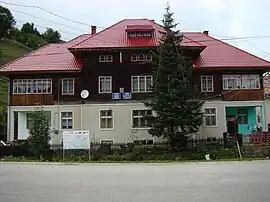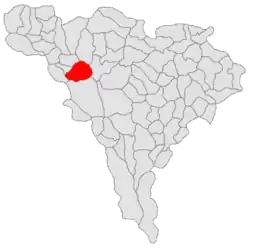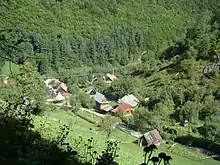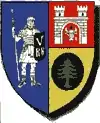Bucium, Alba
Bucium (German: Baumdorf; Hungarian: Bucsony) is a commune located in Alba County, Transylvania, Romania. It has a population of 1,272 as of 2021. It is composed of thirty villages: Anghelești, Bisericani, Bucium, Bucium-Sat (Bucsum-Szát), Cerbu (Bucsum-Cserbu), Ciuculești, Coleșeni, Dogărești, Ferești, Florești, Gura Izbitei, Helești, Izbicioara, Izbita (Bucsum-Izbita), Jurcuiești, Lupulești, Măgura, Muntari (Bucsum-Muntár), Petreni, Poiana, Poieni (Bucsum-Pojén), Stâlnișoara, Vâlcea, Valea Abruzel, Valea Albă, Valea Cerbului, Valea Negrilesii, Valea Poienii, Valea Șesii, and Văleni.
Bucium | |
|---|---|
 Bucium City Hall | |
 Location in Alba County | |
 Bucium Location in Romania | |
| Coordinates: 46°15′50″N 23°10′34″E | |
| Country | Romania |
| County | Alba |
| Government | |
| • Mayor (2020–2024) | Cornel Napău (PSD) |
| Area | 85.7 km2 (33.1 sq mi) |
| Elevation | 951 m (3,120 ft) |
| Population (2021-12-01)[1] | 1,272 |
| • Density | 15/km2 (38/sq mi) |
| Time zone | EET/EEST (UTC+2/+3) |
| Postal code | 517165 |
| Area code | +40 x58 |
| Vehicle reg. | AB |
| Website | primariabucium |
The commune is situated 10 km (6.2 mi) east of Abrud. On its territory can be found a Roman castrum, as well as the ancient open-pit mining sites at Ieruga and Gaura Perii. The Bucium gold deposits are located within the northernmost volcanic belt of the "Golden Quadrilateral," near the Roșia Montană mining town.[2]
The physicist Ion I. Agârbiceanu was a native of Bucium. His father, the writer Ion Agârbiceanu, served as Greek-Catholic parish priest at the church in Bucium–Șasa village (now Ciuculești).
In Béla Bartók's Romanian Folk Dances, the fourth dance is called "Buciumeana", meaning a dance from Bucium.[3]
References
- "Populaţia rezidentă după grupa de vârstă, pe județe și municipii, orașe, comune, la 1 decembrie 2021" (XLS). National Institute of Statistics.
- Ciugudean, Horia Ion (2012). "Ancient Gold Mining in Transylvania: the Roșia Montană–Bucium Area". academia.edu. Retrieved May 9, 2020.
- David Cooper, Béla Bartók, p. 138. New Haven: Yale University Press, 2015, ISBN 978-030-02-1307-2


